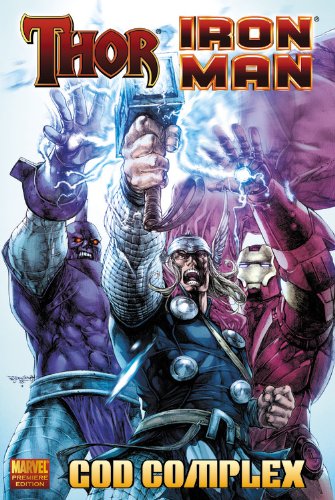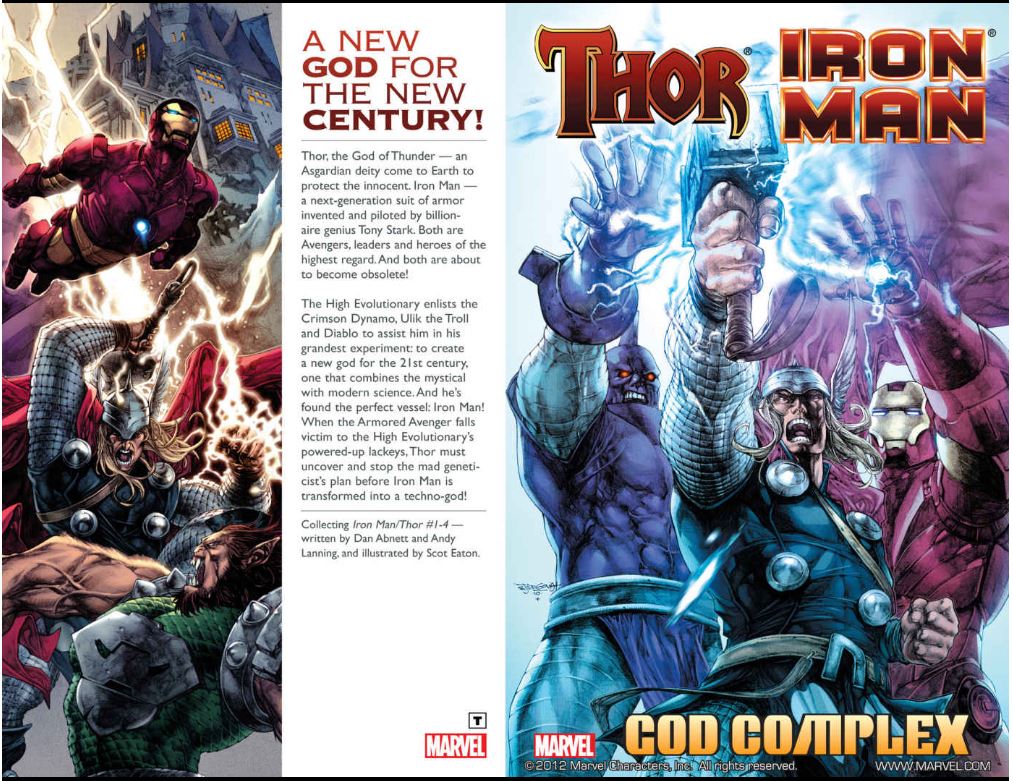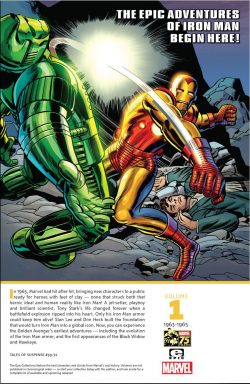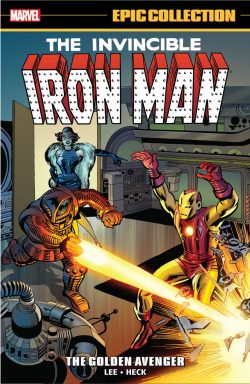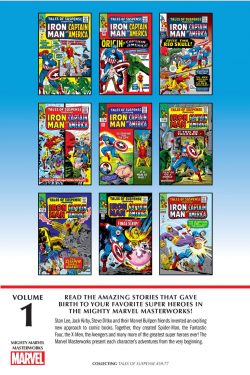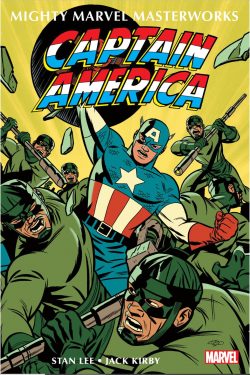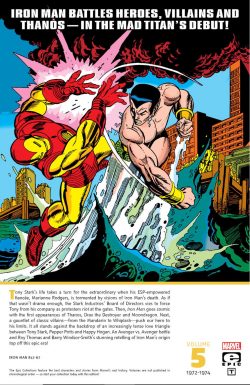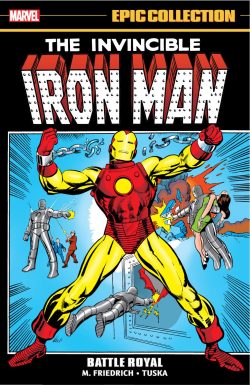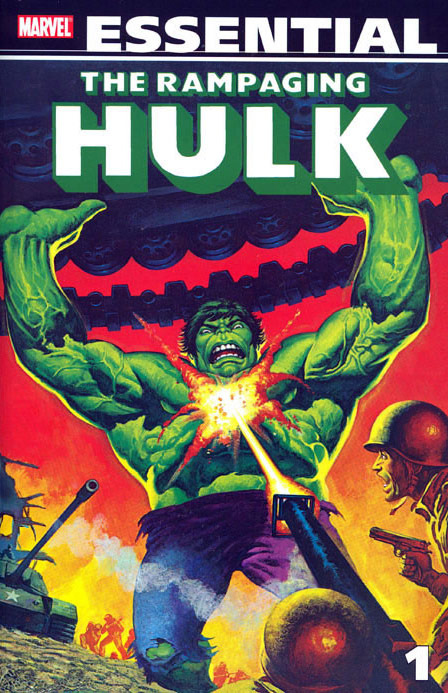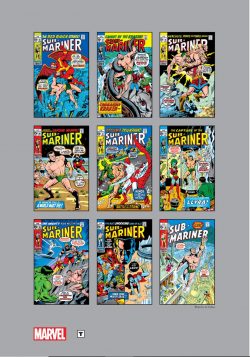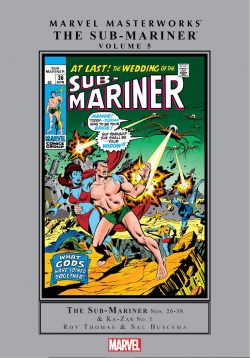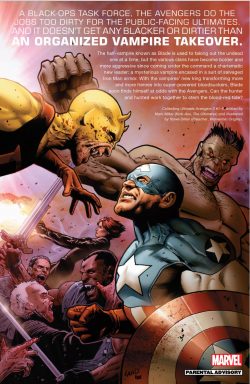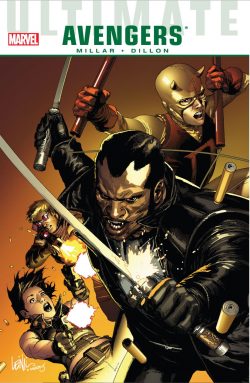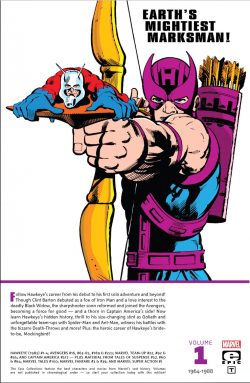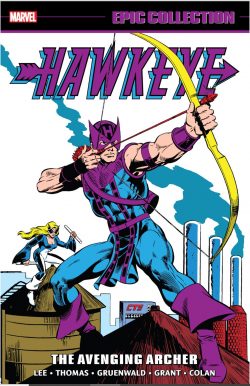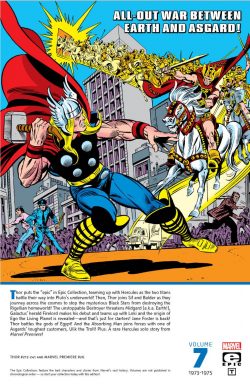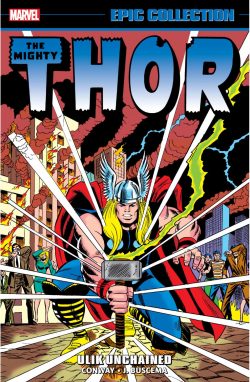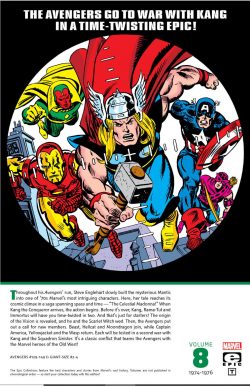
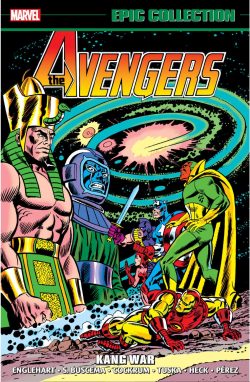
By Steve Englehart, Roy Thomas, Tony Isabella, Sal Buscema, Dave Cockrum, George Tuska, Don Heck, George Pérez, Keith Pollard, Joe Staton & various (MARVEL)
ISBN: 978-1-3029-3352-4 (TPB/Digital edition)
Win’s Christmas Gift Recommendation: Amazement Assembled!… 9/10
One of the most momentous events in comics (and now, film) history came in the middle of 1963 when a disparate gang of heroic individuals banded together to combat an apparently out of control Incredible Hulk.
The Avengers combined most of the company’s fledgling superhero line in one bright, shiny and highly commercial package. Over intervening decades the roster has never stopped changing, and now almost every character in the Marvel multiverse has at some time numbered amongst their colourful ranks…
After instigators Stan Lee & Jack Kirby moved on, the team prospered under the guidance of Roy Thomas who grew into one of the industry’s most impressive writers, directing the World’s Mightiest Heroes through adventures ranging from sublimely poetic to staggeringly epic. He then handed over the scripting to a young writer who carried the team to even greater heights…
This stunning compilation assembles Avengers #129-149 and Avengers Giant-Size #2-4: collectively covering November 1974 to July 1976, to conclude an era of cosmic catastrophe and cataclysmically captivating creativity.
The Avengers have always proved that putting all one’s star eggs in a single basket pays off big-time: even when all Marvel’s classic all-stars such as Thor, Captain America and Iron Man were absent, it merely allowed the team’s lesser lights to shine more brightly. Of course, as in this volume, the founding stars were regularly featured due to the rotating, open door policy which meant that every issue included somebody’s fave-rave. The boldly grand-scaled stories and artwork are no hindrance either.
It all begins as Englehart explores the outer limits of Marvel history and cosmic geography to construct an epic revelation of universal structure, the true beginnings of Marvel time and the formative years of some of the most intriguing characters in comics…
The drama opens with Avengers #129 and ‘Bid Tomorrow Goodbye!’ (illustrated by Sal Buscema & Joe Staton) as Kang the Conqueror abruptly appears, determined to possess the legendary female figure he calls “the Celestial Madonna.”
Apparently, this anonymous being will birth the saviour of the universe, but since no records survive disclosing which of the three women in Avengers Mansion at that crucial moment – mutant sorcery student Scarlet Witch, martial artist Mantis and aged witch Agatha Harkness – she actually is, the time-reaver is resolved to capture all three and forcibly make himself the inevitable father of the child…
This time, not even the assembled Avengers can stop him and, after crushing and enslaving them, Kang makes off with his hostages, leaving only the recently-injured and swiftly declining Swordsman free to contest him…
The tale continues in Giant-Size Avengers #2, with ‘A Blast from the Past!’ (limned by Dave Cockrum) as reluctant returnee Hawkeye rushes to the fallen team’s rescue, uniting with old adversary/mentor Swordsman and enigmatic entity Rama-Tut – who eventually reveals himself as Kang’s reformed future self…
Against all odds, the merely mortal heroes manage to liberate the enslaved Avengers and rout the unrepentant Kang – but only at the cost of Swordsman’s life…
Avengers #130 posed ‘The Reality Problem!’ (with art from Sal B & Staton), depicting how heartbroken and much-chastened Mantis joins the team in Vietnam to investigate her mysteriously clouded past, only to be drawn into pointless combat with Soviet/Chinese Communist exiles and former Avenger foes Titanium Man, Radioactive Man and Crimson Dynamo …thanks to the devious manipulations of petty sneak thief The Slasher…
Brief but heated battle concluded, the origin trail leads to ‘A Quiet Half-Hour in Saigon!’ during which the American adventurers are again attacked by Kang, who traps them in Limbo and unleashes against them a macabre Legion of the Unliving comprising mind-controlled, currently “dead” heroes plucked from the corridors of history…
With yet another chronal villain Immortus added to the mix, ‘Kang War II’ sees resurrected heroes and villains Wonder Man, 1940’s android Human Torch, the Monster of Frankenstein, martial arts assassin Midnight, the actually spectral Flying Dutchman and the first Baron Zemo decimate the team. Moreover, the trauma and tragedy are further exacerbated as Mantis keeps seeing the ghost of her dead lover…
This absorbing thriller by Englehart, Roy Thomas, Sal Buscema & Staton segues inexorably into Giant-Size Avengers #3’s ‘…What Time Hath Put Asunder!’ Illustrated by Cockrum & Joe Giella, it sees Earth’s Mightiest Heroes pulling victory from the ashes of defeat and receiving a unique gift from one of the assembled Masters of Time…
Avengers #133 voyages to ‘Yesterday and Beyond…’ (by Englehart, Sal B & Staton) as the shocked heroes accompany Mantis to the beginnings of recorded Galactic history to unravel of her true past, whilst The Vision is separately dispatched to glimpse his own obscure and complex origins: a double quest encompassing both the Kree and Skrull empires, the previously defeated monstrous Star-Stalker, long-deceased Priests of Pama, Thanos and telepathic Titan Moondragon, as well as a goodly portion of classic superhero history in ‘The Times That Bind!’ before #135 reveals how ‘The Torch is Passed!’ (limned by George Tuska & Frank Chiaramonte), before bringing all the disparate elements together in Giant-Size Avengers #4.
‘…Let All Men Bring Together’ (art by Don Heck & John Tartaglione) brings a satisfactory conclusion to the long-standing. pitfall-plagued romance between the Scarlet Witch and Vision and details another, far more cosmic union with a brace of weddings and the ultimate ascension of the Celestial Madonna – despite demonic extra-dimensional despot Dormammu attempting to despoil the matrimonial celebrations…
A new era was supposed to begin in Avengers #136 but a deadline was missed and instead ‘Iron Man: DOA!’ by Englehart, Tom Sutton & Mike Ploog was reprinted from Amazing Adventures #12, wherein the newly-mutated and furry Hank McCoy AKA The Beast had attacked the Armoured Avenger whilst mind-controlled by evil mutants. You can find the story here.
This book, however, only offers the spiffy cover by Gil Kane, Joe Sinnott & John Romita, before normal service resumed with the Assemblers addressing their staffing issues by declaring ‘We Do Seek Out New Avengers!!’
Illustrated by Tuska & Vince Colletta, #137 depicted an eclectic mix of applicants – including Moondragon, Yellowjacket and The Wasp and an athletic, enigmatic guy bundled up in a raincoat…
No sooner have introductions begun than a cosmic villain attacks, hunting the honeymooning Scarlet Witch and Vision, but at far from his expected level of puissance. Easily escaping imminent doom, our heroes smell a rat – but sadly, not before the Wasp is gravely injured, resulting in a blazing battle with a ‘Stranger in a Strange Man!’ who proves to be far from what he claims…
After all the intergalactic, hyper-cosmic extravaganzas and extended epic antics, Avengers #139’s ‘Prescription: Violence!’ and #140’s ‘A Journey to the Center of the Ant’ resort to mayhem on a comfortingly down-to-Earth scale as malevolent foe Whirlwind tries to murder the bed-ridden Wasp, even as her devoted defender and husband Hank Pym/Yellowjacket succumbs to a growing affliction which dooms him to exponentially expand to his death… but only until a refreshed, returned Vision and bludgeoning Beast save the day in an extraordinary riff on classic Avengers history (which you can see in Avengers #93, if you want to)…
A new Englehart saga starts in #141 which also welcomed George Pérez & Colletta as new art team. ‘The Phantom Empire!’ heralded another complex, multi-layered epic combining superheroic Sturm und Drang with searing – for 1975, at least – political commentary. It all starts when Beast is ambushed by mercenaries from corporate behemoth Roxxon Oil.
He’s saved by ex-Avenger Captain America who had been investigating the company on a related case and – after comparing notes – realises something very big and very bad is going on…
Linking up with Thor, Iron Man, trainee Moondragon and the newly-returned newlyweds Vision and Scarlet Witch, they learn of another crisis after Hawkeye goes missing: probably captured by time-tyrant Kang…
Just as the Assemblage are splitting into teams, former child model Patsy Walker-Baxter (star of a bunch of Marvel’s girls’ market titles such as Patsy Walker and Patsy & Hedy) bursts in, threatening to expose Beast’s secret identity…
When he had first further mutated, McCoy had attempted to mask his anthropoid form, with Patsy helping in return for his promise to make her a superhero. Now she resurfaces, prepared to blackmail him into honouring his pledge. She is dragged along as one squad (Cap, Iron Man, Scarlet Witch and Vision) join Beast in returning to his old lab at Brand/Roxxon …where they are ambushed by alternate-Earth heroes The Squadron Supreme…
Meanwhile, Moondragon and Thor co-opt sometime ally Immortus and follow Hawkeye back to 1873. Bushwhacked, they are soon battling Kang beside a coterie of cowboy legends (Kid Colt, Night Rider, Ringo Kid, Rawhide Kid and Two-Gun Kid) in ‘Go West, Young Gods!’, even as the present-day team learn their perilous plight involves a threat to two different dimensions…
Roxxon have joined with the corporations that rule the Squadron Supreme’s parallel-Earth America – thanks to the malignly mesmeric Serpent Crown of Set. Inked by Sam Grainger, Avengers #143 sees the Wild West showdown culminate with the apparent death of a deity in ‘Right Between the Eons!’
Elsewhen, the 20th century heroes have commenced a counterattack in the esoteric weaponry factory at Brand, and – whilst running rampant – liberate from a storeroom a technologically-advanced, ability-enhancing uniform originally belonging to short-lived adventurer The Cat. When Patsy dons it, the hero-groupie neophyte dubs herself Hellcat in ‘Claws!’ (Mike Esposito inks)…
Soon after, the Avengers are cornered by the Squadron and as battle resumes, Roxxon president Hugh Jones plays his trump card and transports all combatants to the other Earth…
The dreaded deadline doom hit just at this crucial juncture and issues #145-146 were taken up with a 2-part fill-in by Tony Isabella, Heck & Tartaglione, with additional pencils by Keith Pollard for the concluding chapter.
‘The Taking of the Avengers!’ reveals how a criminal combine takes out a colossal contract on the team, but even though ‘The Assassin Never Fails!’ the killer is thwarted and Captain America, Thor, Iron Man, Hawkeye, Beast, Vision and Scarlet Witch, Wasp, Yellowjacket and The Falcon are all safely returned to their various cases, untroubled by the vagaries of continuity or chronology… which makes this rather impressive yarn such an annoyance in this specific instance…
Trans-dimensional traumas resume in Avengers #147, describing a ‘Crisis on Other-Earth!’ courtesy of Englehart, Pérez & Colletta). With the corporate takeover of other-America revealed to have been facilitated by use of the serpent crown, the Scarlet Witch takes possession of the sinister helm as her teammates try desperately to keep the overwhelming Squadron Supreme from reclaiming it.
On our Earth, Hawkeye brings Two-Gun Kid to the modern world, but chooses to go walkabout rather than rejoin his comrades, even as Thor and Moondragon start searching for their missing colleagues…
‘20,000 Leagues Under Justice!’ (Grainger inks) begins the final showdown with the Avengers’ victory over a wiser and repentant Squadron Supreme, and as the heroes return to their home dimension ‘The Gods and the Gang!’ reunites them with Moondragon and the Thunder God in time to clean up Brand/Roxxon. However, the Corporate cabal has one nasty trick left to play: a colossal, biologically augmented Atlantean dubbed Orka, the Human Killer Whale!’ He’s not enough to save them…
Supplementing the circumstances above described is the cover to all-reprint Giant-Size Avengers #5 (by John Buscema & George Roussos) and contemporaneous features from Marvel’s FOOM magazine #12 which spotlighted the romance and weddings with a Vision cover by John B & P. Craig Russell, back cover image by Paty (Cockrum) & Al Milgrom; an overview of the awesome android in ‘Visions’ and ‘Vision, This is Your Life!’ and David Anthony Kraft’s ‘The Scarlet Witch: Meditations on a Ms.’ – all including early art contributions from John Byrne, Paty, Dave Wenzel – plus an extended family pin-up.
Also on view are a Charley Parker spoof strip starring ‘The Visage’, extended interviews ‘Steve Englehart Speaks!: Journey to the center of a Vision’ and ‘Roy Thomas Speaks!: Journey to the center of a Vision’.
The next issue would see a drastic changing of the guard, but this epic tome concludes with even more extras including the covers – by Jack Kirby & Frank Giacoia – and Frontispiece contents page of tabloid Marvel Treasury Edition #7; a wealth of rousing house ads; Neal Adams’ painted cover for Marvel Index #3, its back cover by Franc Reyes and Frontispiece by Peter Iro; the pre-corrections cover to Giant-Size Avengers #2 plus pages of original art by Sal Buscema, Staton, Tuska & Chiaramonte.
Roy Thomas and Steve Englehart were at the forefront of Marvel’s second generation of story-makers, brilliantly building on and consolidating the compelling creation of Lee, Kirby & Ditko: spearheading and constructing a logical, fully functioning miracle-machine of places and events that so many others were inspired by and could add to. Between them they also showed how much more graphic narratives could be, and these terrific tales are perfect examples of superhero sagas done just right.
This type of timeless heroic adventure set the tone for fantastic Fights ‘n’ Tights dramas for decades to come and can still boggle the mind and take the breath away, even here in the sleek, cool and permanently perilous 21st century…
No lovers of Costumed Dramas can afford to ignore this superbly bombastic book and fans who think themselves above superhero stories might also be pleasantly surprised…
© 2022 MARVEL.
